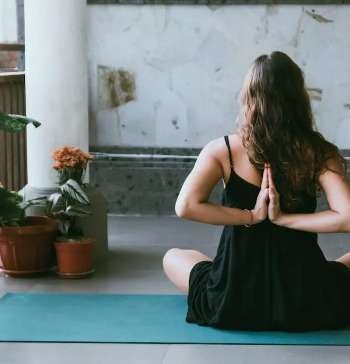Finding tranquility in the midst of life’s chaos can be a challenge, especially for women juggling numerous responsibilities. The daily grind often leaves us feeling stressed, anxious, and disconnected from our inner selves.
But fear not, for there is a solution that can bring calm and balance into your life: creating a home meditation space. In this guide, we’ll explore ten insightful ways to design a sanctuary right in your own home, tailored specifically for women like you who seek solace and mindfulness.
Choose the Perfect Location.

Find Your Zen Zone.
The first step in creating a meditation space is selecting the ideal location. This area should be free from distractions and noise.
Look for a corner of your home that feels serene and inviting. It could be a spare room, a cozy nook in your bedroom, or even a quiet corner in your living room.
Ensure that it’s a space where you can truly relax and connect with your inner self.
Incorporate Nature Indoors.
Consider bringing nature indoors. Place your meditation space near a window with a view of nature, or use houseplants to infuse the room with natural elements. Nature has a calming effect and can enhance your meditation experience.
Personal Touches Matter.
Don’t forget to personalize the space with items that bring you comfort, like soft cushions, blankets, or meaningful artwork. This will help create a sense of belonging and make your meditation space uniquely yours.
Selecting the perfect location for your meditation space is a pivotal decision. It’s the foundation upon which you’ll build your oasis of tranquility. Whether you have an entire room to spare or just a small corner, it’s essential that this space resonates with you. Look for an area that’s shielded from distractions, be it the bustling sounds of daily life or the sight of household chores awaiting your attention.
It’s also a wonderful idea to incorporate elements of nature into your chosen location. Placing your meditation space near a window that overlooks a garden or using indoor plants can infuse the space with a sense of natural calm. The soothing presence of nature can enhance your meditation practice and create a deeper connection with the world around you.
But it doesn’t stop there. Personal touches matter more than you might think. The inclusion of items like plush cushions, cozy blankets, or artwork that holds sentimental value can make your meditation space feel like a warm embrace. These personal elements will make your sanctuary uniquely yours, inviting you to return to it time and time again.
Mindful Furniture Selection.
Comfort is Key.
When choosing furniture for your meditation space, prioritize comfort. A comfortable chair, cushion, or yoga mat is essential for prolonged meditation sessions. Look for ergonomic options that support your posture and allow you to relax.
Keep It Simple.

Opt for simple and minimalistic designs. Clutter-free surroundings can help declutter your mind. Choose furniture that complements the overall theme of your meditation space and provides a sense of tranquility.
The selection of furniture for your meditation space should revolve around one key principle: comfort is paramount. Whether you opt for a cozy chair, a plush cushion, or a dedicated yoga mat, ensure that your choice caters to your comfort during extended meditation sessions. Your posture and physical ease play a significant role in your ability to focus and unwind.
Furthermore, simplicity in design should be your guiding light when it comes to furnishing this sacred space. Clean lines, uncluttered surfaces, and minimalist aesthetics contribute to a serene atmosphere.
These elements work in harmony to declutter not just your physical surroundings but also your mental landscape, allowing you to immerse yourself fully in the practice of meditation.
Calming Colors and Lighting.
Color Psychology.
Colors play a significant role in setting the mood of your meditation space. Soft, soothing colors like pastel blues, gentle greens, and calming purples can promote relaxation and inner peace. Avoid loud and distracting colors that might disrupt your focus.
Natural Lighting.
Natural light is your best friend. Position your meditation space to receive ample natural light during the day. However, if your space lacks natural light, opt for soft, warm artificial lighting that mimics sunlight. Avoid harsh fluorescent lights that can be jarring.
The colors you choose for your meditation space are not merely aesthetic decisions; they are powerful mood-setters. Delicate pastel blues, muted greens, and soothing purples can create an ambiance of tranquility and peace, which is ideal for meditation. These colors can help you disconnect from the chaos of the outside world and dive deep into your inner sanctuary.
Natural lighting, if available, is a treasure. Position your meditation space in a way that allows you to bask in the gentle embrace of natural light during the day. The warmth of the sun’s rays can elevate your meditation experience.
In the absence of abundant natural light, opt for soft, warm artificial lighting that replicates the qualities of sunlight. This artificial illumination should be gentle on the eyes, steering clear of harsh fluorescent lights that can be jarring and disrupt your peaceful meditation practice.
Engage Your Senses.

Aromatherapy.
Engaging your senses can deepen your meditation experience. Consider using essential oils or incense to create a pleasant aroma in your meditation space. Scents like lavender, sandalwood, and eucalyptus are known for their calming properties.
Soothing Sounds.
Soft background music or nature sounds can help drown out distractions and promote mindfulness. Invest in a good-quality speaker or use a smartphone app to play relaxing sounds like ocean waves, birdsong, or gentle rainfall.
Engaging your senses is a powerful way to enhance your meditation practice. Aromatherapy, in particular, can elevate your experience.
Consider using essential oils or incense to infuse your meditation space with a pleasant aroma. Scents like lavender, known for its calming properties, sandalwood, which promotes tranquility, or eucalyptus, for its refreshing qualities, can transport you to a more peaceful state of mind.
In addition to scent, sound can also be a powerful tool. Soft background music or soothing nature sounds can help drown out external distractions and create a serene ambiance.
To fully appreciate these auditory elements, invest in a good-quality speaker or make use of meditation apps that offer a variety of calming soundscapes, such as ocean waves, birdsong, or gentle rainfall. These sounds can serve as a soothing backdrop to your meditation practice, helping you find deeper focus and relaxation.
Declutter and Organize.
Less is More.
A cluttered space can lead to a cluttered mind. Keep your meditation space tidy and organized. Use storage solutions like shelves, cabinets, or decorative boxes to stow away any items that don’t contribute to the serenity of the space.
Energy Flow.
Ensure good energy flow in the room by keeping pathways clear and avoiding furniture placement that blocks natural movement. This will help maintain a harmonious atmosphere in your meditation space.
Creating a clutter-free environment is essential for a successful meditation practice. The principle here is simple: less is more. A cluttered space can easily translate into a cluttered mind, making it challenging to focus and find inner peace. To counter this, maintain your meditation space in a tidy and organized state.
Invest in practical storage solutions such as shelves, cabinets, or decorative boxes to stow away items that don’t contribute to the serenity of the space. This keeps your meditation area visually clean and uncluttered
ed, allowing you to immerse yourself fully in your practice.
Additionally, consider the flow of energy within the room. Ensure that pathways are clear and there are no obstacles that disrupt the natural movement of energy. This will help maintain a harmonious atmosphere, allowing positive energy to flow freely during your meditation sessions.
Create a Sacred Altar.
Meaningful Symbols.
A sacred altar is a beautiful addition to your meditation space. It can hold objects of personal significance, such as crystals, candles, or spiritual symbols. These items can serve as focal points during your meditation practice.
Daily Rituals.
Incorporate daily rituals into your meditation routine. Lighting a candle or placing fresh flowers on your altar can signify the beginning of your mindfulness practice. It’s a way to set your intentions and create a sacred atmosphere.
A sacred altar is a powerful and symbolic addition to your meditation space. It serves as a focal point for your practice, anchoring your thoughts and intentions. On this altar, you can place objects of personal significance, such as crystals that resonate with you, candles to represent the illumination of your inner self or spiritual symbols that hold deep meaning.
Beyond its physical elements, your sacred altar can be a site of daily rituals. These rituals can mark the commencement of your meditation practice, creating a sense of reverence and intention.
Lighting a candle or placing fresh flowers on your altar can symbolize the beginning of your mindfulness journey, setting a sacred atmosphere that invites inner exploration and self-discovery. Such rituals can serve as powerful reminders of the importance of your meditation practice in your daily life.
Establish a Routine.
Consistency is Key.
To truly benefit from your meditation space, establish a regular meditation routine. Consistency is key to reaping the rewards of mindfulness. Set aside a specific time each day to practice meditation in your designated space.
Mindful Preparation.
Before you start your meditation session, take a few moments to prepare. You can do this by deep breathing, stretching, or simply sitting quietly to center yourself. This helps you transition into a meditative state more smoothly.
Consistency is the cornerstone of an effective meditation practice. Once you’ve created your meditation space, it’s essential to establish a routine. Consistency is the key to unlocking the full potential of mindfulness and reaping its benefits.
Select a specific time each day to practice meditation in your designated space. Whether it’s in the morning to set a positive tone for the day or in the evening to unwind, having a set schedule helps anchor your practice in your daily life.
Before you begin your meditation session, engage in mindful preparation. This can involve a variety of techniques, such as deep breathing exercises, gentle stretching, or simply sitting in silence to center yourself.
These moments of preparation serve as a bridge between your busy external world and the peaceful sanctuary of your meditation space, allowing you to transition into a meditative state with ease and grace.
Embrace Technology Wisely.
Use Meditation Apps.
Incorporate technology in a mindful way. There are numerous meditation apps available that can guide you through meditation sessions, provide soothing music, and track your progress. These tools can be valuable aids in your practice.

Digital Detox.
However, be mindful of not letting technology become a distraction in your meditation space. Set your devices to “Do Not Disturb” mode and silence notifications to maintain a peaceful atmosphere.
Technology can be both a boon and a bane when it comes to your meditation space. On one hand, there are meditation apps available that can be valuable aids in your practice. These apps offer guided meditation sessions, soothing music, and progress-tracking features, all of which can enhance your mindfulness journey.
However, it’s essential to use technology mindfully. While meditation apps can be beneficial, they can also become distractions if not managed wisely.
To ensure that technology doesn’t disrupt the serenity of your meditation space, set your devices to “Do Not Disturb” mode and silence notifications during your practice sessions. This small step can go a long way toward maintaining a peaceful atmosphere and preventing external interruptions from pulling you away from your inner sanctuary.
Seek Inspiration.
Read and Reflect.
Expand your knowledge and deepen your practice by keeping books, journals, or inspirational quotes in your meditation space. Reading a passage or journaling your thoughts before or after meditation can be enlightening.
Connect with a Community.
Consider joining a meditation group or community. Sharing your experiences and insights with others can enhance your journey and provide valuable support.
Meditation is a journey of self-discovery and continuous growth, and your meditation space can be a place of inspiration along the way. Keep books, journals, or inspirational quotes in your sanctuary to expand your knowledge and deepen your practice.
Before or after meditation sessions, take a moment to read a passage from a book that resonates with you or journal your thoughts and reflections. These practices can be enlightening, offering new perspectives and insights that enrich your mindfulness journey.
Additionally, consider connecting with a meditation group or community. Sharing your experiences and insights with others who are on a similar path can be profoundly rewarding. It provides an opportunity to learn from one another, gain support, and foster a sense of belonging in your mindfulness practice.
Adjust as Needed.
Evolving Space.
Your meditation space is a reflection of your inner journey, and it may evolve over time. Don’t hesitate to make adjustments as needed. Your needs and preferences may change, and your meditation space should adapt accordingly.
Meditation as Self-Care.
Remember that your meditation space is a sacred sanctuary for self-care. It’s a place where you can retreat, recharge, and find solace whenever life gets overwhelming.
As you embark on your meditation journey, keep in mind that your meditation space is a dynamic reflection of your inner growth and evolution. It may change over time, just as you do. Embrace this evolution and be open to making adjustments as needed.
Your needs and preferences may shift as you progress in your mindfulness practice. Perhaps you’ll find that you require different elements in your meditation space, or you may discover that certain adjustments enhance your practice further. Allow your meditation space to adapt alongside you, ensuring that it remains a harmonious and nurturing environment.
Ultimately, your meditation space is a sacred sanctuary for self-care. It’s a space where you can retreat, recharge, and find solace whenever life becomes overwhelming. Treat it with the utmost care and reverence, knowing that it holds the key to your inner peace and balance.
Tips for Creating Your Home Meditation Space.
| Point | Description |
|---|---|
| Choose the Perfect Location | Find a serene and distraction-free space in your home. Consider incorporating natural elements and personal touches. |
| Mindful Furniture Selection | Prioritize comfort with ergonomic furniture and embrace minimalistic designs for a clutter-free atmosphere. |
| Calming Colors and Lighting | Choose soothing colors and natural lighting to set a tranquil mood in your meditation space. |
| Engage Your Senses | Enhance your experience with aromatherapy and soothing sounds like nature recordings. |
| Declutter and Organize | Maintain a clutter-free environment and ensure good energy flow in your meditation space. |
| Create a Sacred Altar | Personalize your space with meaningful objects and incorporate daily rituals for a sacred atmosphere. |
| Establish a Routine | Set a consistent meditation schedule and engage in mindful preparation before each session. |
| Embrace Technology Wisely | Use meditation apps mindfully and ensure technology doesn’t disrupt your meditation space. |
| Seek Inspiration | Expand your knowledge through reading and reflection, and consider connecting with a meditation community. |
| Adjust as Needed | Be open to evolving your meditation space as your needs and preferences change over time. |
In this table, you’ll find a concise summary of the ten key points for creating your home meditation space. Each point is accompanied by a brief description to help you understand its importance and how to implement it in your sanctuary.
Conclusion.
Creating a home meditation space is a powerful way for women to cultivate mindfulness, reduce stress, and nurture their well-being. It’s an investment in your mental and emotional health, and the benefits are profound.
By selecting the perfect location, choosing comfortable furniture, and incorporating calming colors and lighting, you set the stage for a serene and inviting space. Engaging your senses, decluttering, and organizing create an environment conducive to mindfulness.
Adding a sacred altar and establishing a routine help anchor your meditation practice. Embracing technology wisely and seeking inspiration from books or meditation communities can enhance your journey. Lastly, be open to adjustments as your meditation space evolves with your inner growth.
So, go ahead and embark on this journey of self-discovery and tranquility by creating your own home meditation space. It’s a gift you give yourself, allowing you to find peace, balance, and serenity in the comfort of your own home. Remember, you deserve this oasis of calm amidst life’s hustle and bustle.

Dive deep into the world of Neha Z., a passionate writer and seasoned blogger. For over half a decade, she’s been sharing her life’s stories and experiences. Neha’s expertise isn’t just limited to her personal tales; she delves into everything women-centric. From life’s ups and downs to the nuances of womanhood, if it’s about women, Neha writes it with flair and authenticity. Join her journey and be inspired by her words!
Reviewed By: Joanna Perez and Edited By: Lenny Terra
Fact Checked By: Brenda Tillman
Photos Taken or Curated By: Matthew Mansour